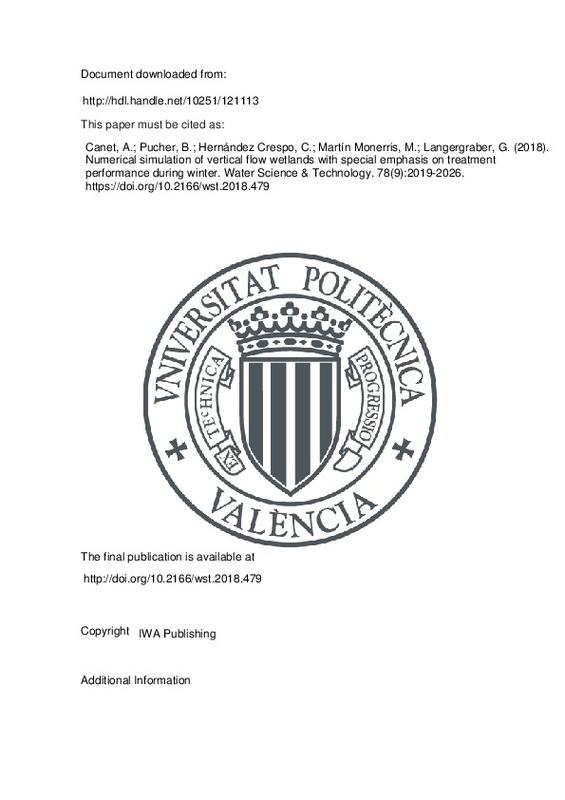JavaScript is disabled for your browser. Some features of this site may not work without it.
Buscar en RiuNet
Listar
Mi cuenta
Estadísticas
Ayuda RiuNet
Admin. UPV
Numerical simulation of vertical flow wetlands with special emphasis on treatment performance during winter
Mostrar el registro sencillo del ítem
Ficheros en el ítem
| dc.contributor.author | Canet, Alba
|
es_ES |
| dc.contributor.author | Pucher, Bernhard
|
es_ES |
| dc.contributor.author | Hernández Crespo, Carmen
|
es_ES |
| dc.contributor.author | Martín Monerris, Miguel
|
es_ES |
| dc.contributor.author | Langergraber, Guenter
|
es_ES |
| dc.date.accessioned | 2019-05-26T20:03:10Z | |
| dc.date.available | 2019-05-26T20:03:10Z | |
| dc.date.issued | 2018 | es_ES |
| dc.identifier.issn | 0273-1223 | es_ES |
| dc.identifier.uri | http://hdl.handle.net/10251/121113 | |
| dc.description.abstract | [EN] In Austria, single-stage vertical flow (VF) wetlands with intermittent loading are a state-of-the-art technology for treating domestic wastewater. They are designed according to the Austrian design standard with a specific surface area of 4 m(2) per person (i.e. 20 g COD/(m(2).d)) and thus demand a bigger amount of land to treat the same amount of wastewater compared to intensified technical treatment systems. In order to reduce the amount of land needed, a modified design for VF wetlands has been proposed. The modified design has a specific surface area of 2.5 m(2) per person (i.e. 32 g COD/(m(2).d)) and it has been shown to be able to meet the Austrian effluent requirements. To allow higher organic loading, more loadings per day but lower volume of a single loading, a constant loading interval, and increased number of openings per m(2) are applied. A simulation study using the HYDRUS Wetland Module was carried out to compare the treatment efficiencies of single-stage VF wetlands with classical and modified design. Data from a classical Austrian single-stage VF wetland was used for calibration of the model using the standard parameter set for the CW2D biokinetic model. The influent COD fractionation was calibrated to adapt to the wastewater. The simulations showed a good performance of the modified design compared to a classical VF wetland for COD removal with COD effluent concentrations in winter (effluent water temperature of 4.5 degrees C) of 35 and 29 mg/L, respectively. The simulation study showed that during high-loading events the VF wetland with modified design has lower maximum NH4-N effluent concentrations. Single-stage VF wetlands with modified design seem to be very effective and allow application of higher organic loads compared to single-stage VF wetlands with classical design. | es_ES |
| dc.description.sponsorship | The stay of Alba Canet Marti in Vienna was funded by an ERASMUS+ scholarship. The authors are grateful for the support. | es_ES |
| dc.language | Inglés | es_ES |
| dc.publisher | IWA Publishing | es_ES |
| dc.relation.ispartof | Water Science & Technology | es_ES |
| dc.rights | Reserva de todos los derechos | es_ES |
| dc.subject | HYDRUS wetland module | es_ES |
| dc.subject | Numerical simulation | es_ES |
| dc.subject | Specific surface area | es_ES |
| dc.subject | Treatment wetlands | es_ES |
| dc.subject | Vertical flow | es_ES |
| dc.subject.classification | TECNOLOGIA DEL MEDIO AMBIENTE | es_ES |
| dc.title | Numerical simulation of vertical flow wetlands with special emphasis on treatment performance during winter | es_ES |
| dc.type | Artículo | es_ES |
| dc.identifier.doi | 10.2166/wst.2018.479 | es_ES |
| dc.rights.accessRights | Abierto | es_ES |
| dc.contributor.affiliation | Universitat Politècnica de València. Departamento de Ingeniería Hidráulica y Medio Ambiente - Departament d'Enginyeria Hidràulica i Medi Ambient | es_ES |
| dc.description.bibliographicCitation | Canet, A.; Pucher, B.; Hernández Crespo, C.; Martín Monerris, M.; Langergraber, G. (2018). Numerical simulation of vertical flow wetlands with special emphasis on treatment performance during winter. Water Science & Technology. 78(9):2019-2026. https://doi.org/10.2166/wst.2018.479 | es_ES |
| dc.description.accrualMethod | S | es_ES |
| dc.relation.publisherversion | http://doi.org/10.2166/wst.2018.479 | es_ES |
| dc.description.upvformatpinicio | 2019 | es_ES |
| dc.description.upvformatpfin | 2026 | es_ES |
| dc.type.version | info:eu-repo/semantics/publishedVersion | es_ES |
| dc.description.volume | 78 | es_ES |
| dc.description.issue | 9 | es_ES |
| dc.identifier.pmid | 30566105 | |
| dc.relation.pasarela | S\384623 | es_ES |
| dc.contributor.funder | European Commission |







![[Cerrado]](/themes/UPV/images/candado.png)

